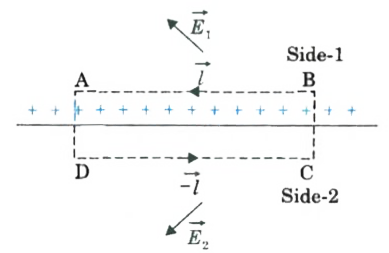(a) Show that the normal component of electrostatic field has a discontinuity from one side of a charged surface to another given by:
where is a unit vector normal to the surface of a point and is the surface charge density at that point. (The direction of is from side 1 to side 2). Hence, show that just outside a conductor, the electric field is .
(b) Show that the tangential component of electrostatic field is continuous from one side of a charged surface to another.
(a) The electric field due to a charged surface having surface charge density is given by:
Let us consider a charged surface carrying surface charge density as shown in the figure.

The electric field intensity at the side-2 is given by:
The electric field intensity at side-1 is given by:
There will be discontinuity in the electric field due the charged surface as the directions of the will be opposite.
Thus, the discontinuity in the electric field is given by,
Since the difference of the electric field intensities on the two sides of the surface is non-zero, the two electric fields are unequal. So, there is a discontinuity.
In case of the surface is conducting the electric field will be zero at its one side because that lies inside the conductor.s volume. Thus, on substituting
(b) 
Let be the electric fields on both sides of the charged surface.
Let us assume a rectangular loop of negligible width and length as shown in above figure. Side AB of the loop is on side-1 of the charged surface and the side CD is on the side-2 of the charged surface.
As we know the net work done in moving a charged particle in a closed loop is zero inside electrostatic field.
Thus, work done in moving a unit charged particle along ABCD must be zero.
[The width of the loop AD and BC is neglected]
Thus,
Here, are the angles made by and with the charged surface. are the tangential components of the electric field on two sides of the surface and we have proved them to be equal. Hence, the tangential component of electric field (if it exists) will be same on both sides.
Topper's Solved these Questions
- ELECTROSTATIC POTENTIAL AND CAPACITANCE Book:MODERN PUBLICATIONChapter:ELECTROSTATIC POTENTIAL AND CAPACITANCE Exercise:NCERT FILE Solved (Additional Exercises) (Answer carefully)
Explore 7 Videos
- ELECTROSTATIC POTENTIAL AND CAPACITANCE Book:MODERN PUBLICATIONChapter:ELECTROSTATIC POTENTIAL AND CAPACITANCE Exercise:NCERT FILE Solved (Additional Exercises) (Answer the following)
Explore 4 Videos
- ELECTROSTATIC POTENTIAL AND CAPACITANCE Book:MODERN PUBLICATIONChapter:ELECTROSTATIC POTENTIAL AND CAPACITANCE Exercise:NCERT FILE Solved (Textbook Exercise)
Explore 11 Videos
- ELECTROMAGNETIC WAVESBook:MODERN PUBLICATIONChapter:ELECTROMAGNETIC WAVESExercise:CHAPTER PRACTICE TEST
Explore 14 Videos
- MAGNETISM AND MATTERBook:MODERN PUBLICATIONChapter:MAGNETISM AND MATTERExercise:CHAPTER PRACTICE TEST FOR BOARD EXAMINATION
Explore 16 Videos
Similar Questions
Show that the normal component of electrostatic field has a discontinuity from one side of a charged surface to another given by
(→E2−→E1).Htan=σε0
where ˆn is a unit vector normal to the surface at a point and o is the surface charge density at that point. (The direction of în is from side 1 to side 2). Hence, show that just outside a conductor, the electric field is σε0ˆn.
View SolutionShow that the normal component of electrostatic field has a discontinuly form one side of a charged. Surface to another given by (−→E2−−→E1).ˆn=σ∈0
where ˆn is a unit vector normal to the surface at a point and σ at a point and σ is the surface charge density at that point. (The direction of ˆn is from side 1 to side 2). Hence show that justy outside a conductor, the electric field σˆn/∈0.
(b) Show that the tangential componet of electrostatic field is contionous from one side fo a charged surface to another.
View SolutionShow that the tangential component of electrostatic field is continuous from one side of charged surface to another. [Hint : use the fact that work done by electrostatic field on a closed – loop is zero.]
View SolutionShow that the tangential component of electrostatic field is continuous from one side of charged surface to another. [Hint : use the fact that work done by electrostatic field on a closed – loop is zero.]
View SolutionShow that the electric field at the surface of a charged conductor is given by →E=σε0ˆn , where σ is the surface charge density and ˆn is a unit vector normal to the surface in the outward direction .
View SolutionShow that the electric field at the surface of a charged conductor is given by →E=σε0ˆn , where σ is the surface charge density and ˆn is a unit vector normal to the surface in the outward direction .
View SolutionA hollow charged conductor has a tiny hole cut into its surface. Show that the electric field in the hole is (σ2∈0)ˆn , where ˆn is the unit vector in the outward normal direction, and σ is the surface charge density near the hole,
View SolutionA hollow charged conductor has a tiny hole cut into its surface. Show that the electric field in the holes is (σ/2ε0) ˆn, where ˆn is the unit vector in the outward normal direction, and σ is the surface charge density near the hole.
View SolutionA hollow charged conductor has a tiny hole cut into its surface. Show that the electric field in the holes is (σ/2∈0 ˆn, where ˆn is the unit vector in the outward normal direction, and σ is the surface charge density near ther hole.
View SolutionA hollow charged conductor has a tiny hole cut into its surface. Show that the electric field in the holes is (σ/2∈0() ˆn, where ˆn is the unit vector in the outward normal direction, and σ is the surface charge density near ther hole.
View Solution

